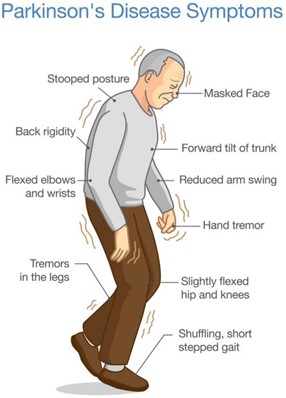A nurse is contributing to the plan of care for a client who has Parkinson's disease. Which of the following interventions should the nurse plan to include?
Restrict the client's fluid intake
Keep suction equipment at the client's bedside
Instruct the client to look down when ambulating
Position the client supine after eating
The Correct Answer is B
b. Keep suction equipment at the client's bedside.
The nurse should plan to include keeping suction equipment at the client's bedside as an intervention for a client with Parkinson's disease. Parkinson's disease can cause dysphagia (difficulty swallowing) and an increased risk of aspiration. Having suction equipment readily available allows for prompt intervention in case of choking or aspiration episodes, ensuring the client's safety.
Explanation for the other options:
a. Restrict the client's fluid intake: Restricting the client's fluid intake is not typically indicated in the care of a client with Parkinson's disease. Adequate hydration is important for overall health and well-being. However, specific fluid restrictions may be necessary in certain situations, such as if the client has coexisting conditions like heart failure or kidney disease, which should be assessed and determined by the healthcare provider.
c. Instruct the client to look down when ambulating: In Parkinson's disease, individuals often experience a forward-flexed posture and a shuffling gait. Instructing the client to look down when ambulating is not an appropriate intervention. Instead, the nurse should encourage the client to maintain an upright posture, take smaller steps, and focus on taking deliberate and controlled movements to promote stability and reduce the risk of falls.
d. Position the client supine after eating: Positioning the client supine after eating is not recommended for a client with Parkinson's disease. This position can increase the risk of aspiration, as it may promote reflux and regurgitation of stomach contents. Instead, the nurse should advise the client to maintain an upright position, such as sitting in a chair or using a recliner with appropriate head support, to aid digestion and reduce the risk of aspiration.

Nursing Test Bank
Naxlex Comprehensive Predictor Exams
Related Questions
Correct Answer is A
Explanation
Immunocompromised individuals have a weakened immune system, which makes them more susceptible to infections. Soiled linens, when placed on the floor, can potentially harbor pathogens and become a source of contamination. It is essential to handle soiled linens properly by placing them in designated containers or bags to prevent the spread of infectious agents.
Uncapped sharps put in a puncture-resistant container: This is the correct practice for disposing of sharps, such as needles or lancets. Uncapped sharps should always be placed in puncture-resistant containers to prevent accidental injuries and potential transmission of infections.
Dampened cloths used for dusting the area: Dampened cloths for dusting can help minimize the dispersal of dust and allergens, but it does not necessarily pose a significant risk of infection.
However, it is important to ensure that the dampened cloths are properly cleaned and sanitized to prevent the growth and spread of microorganisms.
Waste containers lined with single bags: Waste containers lined with single bags are a common practice for proper waste management and disposal. While it is important to maintain good waste management practices to prevent the spread of infections, the use of single bags alone does not significantly affect the risk of infection for immunocompromised clients.
Correct Answer is A
No explanation
Whether you are a student looking to ace your exams or a practicing nurse seeking to enhance your expertise , our nursing education contents will empower you with the confidence and competence to make a difference in the lives of patients and become a respected leader in the healthcare field.
Visit Naxlex, invest in your future and unlock endless possibilities with our unparalleled nursing education contents today
Report Wrong Answer on the Current Question
Do you disagree with the answer? If yes, what is your expected answer? Explain.
Kindly be descriptive with the issue you are facing.
